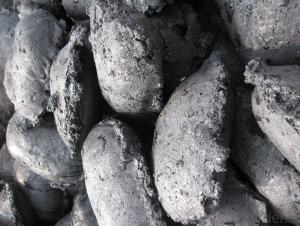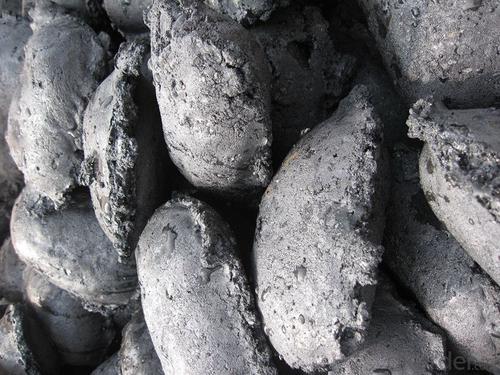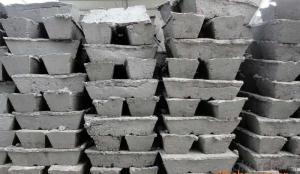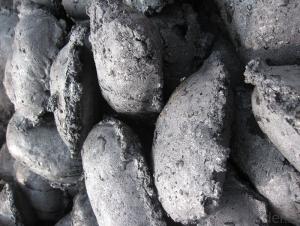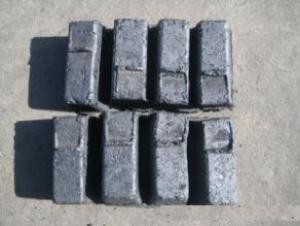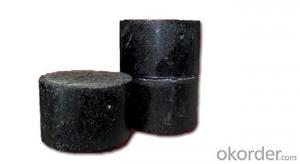Carbon Electrode Paste Block with Low Ash
- Loading Port:
- Lianyungang
- Payment Terms:
- TT OR LC
- Min Order Qty:
- 20 m.t.
- Supply Capability:
- 1000 m.t./month
OKorder Service Pledge
OKorder Financial Service
You Might Also Like
Spcifications
Carbon Electrode Paste Block with Low Ash
1:carbon eletrode paste
2:for ferroalloy,calcium carbide manufacture
3:HS 3801300000,YB/T5212-1996,ISO9001:2008
Product Description
Carbon Electrode Paste Block with Low Ash
Carbon Electrode Paste is a self-baking electrode used in submerged arc furnaces for delivering power to the charge mix. Electrode Paste is added to the top of the electrode column in either cylindrical or briquette form. As the paste moves down the electrode column the temperature increase causes the paste to melt and subsequently bake forming a block of electrically conductive carbon. Electrode Paste is essentially a mix of Electrically Calcined Anthracite (ECA) or Calcined Petroleum Coke (CPC) with Coal Tar Pitch.
Product Feature
Carbon Electrode Paste Block with Low Ash
Graphite/Carbon Electrode Paste
Specification/Item
Ash 4.0%max5.0%max 6.0%max7.0% Max9.0% Max11.0% Max
VM 12.0%-15.5%12.0%-15.5%12.0%-15.5%9.5.0%-13.5%11.5%-15.5%11.5%-15.5%
Strength
Compress 18.0Mpa Min17.0Mpa Min15.7Mpa Min19.6Mpa Min19.6Mpa Min19.6Mpa Min
Specific 65μΩm Max68μΩm Max75μΩm Max80μΩm Max90μΩm Max90μΩm Max
Resistance
Bulk Density1.38G/CM3 Min1.38G/CM3 Min1.38G/CM3 Min1.38G/CM3 Min1.38G/CM3 Min1.38G/CM3 Min
Product Image
Carbon Electrode Paste Block with Low Ash
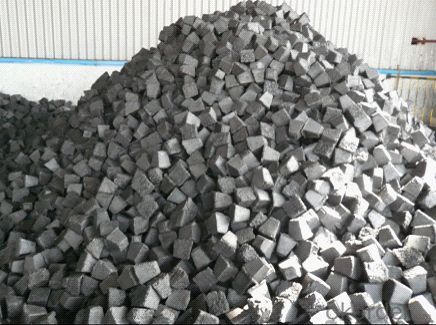
Advantage:
Carbon Electrode Paste Block with Low Ash
1.High quality and competitive price.
2.Timely delivery.
3.If any item you like. Please contact us.
Your sincere inquiries are typically answered within 24 hours.
- Q: What should we do to reduce carbon emissions in our lives?
- The use of public transport, of course, is best to walk long distances, as far as possible the use of roads or railways, aircraft carbon emissions, the largest use of disinfection chopsticks, do not use disposable tableware, handkerchiefs do not use napkins
- Q: What are the impacts of carbon emissions on the stability of mountains?
- Carbon emissions can have various impacts on the stability of mountains. One significant effect is the acceleration of glacial melting, leading to increased water runoff and the potential for more frequent and severe landslides. Additionally, carbon dioxide contributes to the acidification of rainwater, which can corrode rocks and weaken the stability of mountain slopes. Climate change, driven by carbon emissions, also leads to alterations in precipitation patterns, temperature, and weather events, increasing the risk of erosion, rockfalls, and avalanches. Overall, carbon emissions have a detrimental influence on the stability of mountains, posing risks to both human populations and ecosystems.
- Q: What are the advantages of carbon-based fertilizers?
- There are several advantages of carbon-based fertilizers that make them a popular choice among farmers and gardeners. Firstly, carbon-based fertilizers such as compost and manure are organic in nature, which means they are derived from natural sources and do not contain synthetic chemicals. This makes them environmentally friendly and reduces the risk of water pollution or soil degradation. Secondly, carbon-based fertilizers are rich in organic matter, which improves the soil structure and enhances its ability to retain water. This can be particularly beneficial in areas with low soil fertility or frequent droughts, as it helps to conserve moisture and prevent nutrient leaching. Furthermore, carbon-based fertilizers promote the growth of beneficial microorganisms in the soil. These microorganisms break down organic matter and release essential nutrients in a slow and gradual manner, ensuring a steady supply of nutrients to the plants. This improves overall plant health and reduces the risk of nutrient imbalances or deficiencies. Additionally, carbon-based fertilizers are cost-effective in the long run. While they may require more initial effort and time to produce or source, they can be produced on-site through composting or obtained from local sources such as farms or livestock operations. This reduces the need for expensive chemical fertilizers and minimizes transportation costs. Lastly, carbon-based fertilizers contribute to carbon sequestration and help combat climate change. By using organic waste materials as fertilizers, we divert them from landfills where they would emit greenhouse gases. Instead, they are recycled back into the soil, increasing its carbon content and promoting soil health. Overall, carbon-based fertilizers offer numerous advantages in terms of sustainability, soil fertility, cost-effectiveness, and environmental impact. Their use can contribute to healthier plants, improved soil quality, and a more sustainable and resilient agricultural system.
- Q: Appearance, hardness, electrical conductivity, use of carbon 60
- C60 is a molecule composed of 60 carbon atoms in the molecule, it is like football, so also known as footballene (C60. This material is composed of C60 molecules, rather than by the atoms.) C60 is simply made of carbon atoms with stable molecules, it has 60 vertices and 32 sides. The 12 is Pentagon and 20 hexagon. Its molecular weight is about 720.
- Q: What are the effects of carbon emissions on the stability of coastal ecosystems?
- Carbon emissions have significant negative effects on the stability of coastal ecosystems. The increased concentration of carbon dioxide in the atmosphere leads to ocean acidification, which disrupts the delicate balance of marine ecosystems. This acidity affects the growth and development of various organisms such as corals, shellfish, and other calcifying organisms, jeopardizing the health of coral reefs and shellfish populations. Additionally, rising sea levels, a result of climate change caused by carbon emissions, threaten coastal habitats, including wetlands and mangroves, which serve as critical nurseries and protective buffers against storms. Overall, carbon emissions contribute to the degradation and vulnerability of coastal ecosystems, compromising their stability and the services they provide to both marine life and human communities.
- Q: But their chemical symbols are different, so they are different elements, different substances, but they feel the same thing... Tangled up ~!
- No one is the same. Lead is poisonous, and pencil lead is lead. The structure of carbon is the same as that of diamonds. Generally speaking, they are of structure, density and composition. No one is the same
- Q: How does carbon affect the fertility of soil?
- Carbon is essential for maintaining and enhancing soil fertility. It provides a food source for soil microorganisms, promotes nutrient availability, and improves soil structure, water holding capacity, and overall soil health. Additionally, carbon helps increase the capacity of soil to retain and release nutrients, creating a favorable environment for plant growth and enhancing soil fertility.
- Q: What are some natural sources of atmospheric carbon emissions?
- Volcanic eruptions, forest fires, and the decomposition of organic matter are among the natural sources that contribute to atmospheric carbon emissions. When volcanoes erupt, they discharge significant quantities of carbon dioxide and other greenhouse gases into the air. In the case of forest fires, carbon dioxide is released when trees and vegetation burn. Moreover, the breakdown of organic matter, including deceased plants and animals in forests, wetlands, and oceans, produces carbon dioxide as a natural byproduct. These natural processes have been ongoing for millions of years and play a vital role in the carbon cycle, which plays a crucial role in Earth's climate regulation.
- Q: The relative molecular mass was between 120-150. The testThe organic matter M, which contains only carbon, hydrogen and oxygen, was measured by mass spectrometer. The relative molecular mass was between 120-150. The mass fraction of oxygen element measured by experiment is 48.48%, the ratio of hydrocarbon to mass is 15:2, and only COOH in M molecule is measured by infrared spectrometer. Then the M formula is?
- The mass fraction of oxygen element is 48.48%, the mass fraction of hydrocarbon is =51.52%, and the mass ratio is 15:2. The mass fraction of carbon is =51.52%x15/ (15+2) =45.46%, and the mass fraction of hydrogen is =51.52%x2/ (15+2) =6.06%The atomic number of C, H and O is higher than that of =45.46%/12:6.06%/1:48.48%/16=3.79:6.06:3.03Molecules contain only COOH, and oxygen atoms must be even numbers.Therefore, the number of atoms in C, H and O can be reduced to =5:8:4, which may be C5H8O4, and the relative molecular weight is 132
- Q: How does carbon dioxide affect the acidity of rainwater?
- Carbon dioxide affects the acidity of rainwater by contributing to the formation of carbonic acid. When carbon dioxide dissolves in rainwater, it reacts with water molecules to form carbonic acid. This reaction increases the concentration of hydrogen ions (H+) in the water, leading to a decrease in pH and the formation of acidic rainwater. The carbonic acid formed from carbon dioxide is a weak acid, but it can still lower the pH of rainwater, making it more acidic than normal. This increased acidity can have detrimental effects on the environment, including damaging plant and animal life, corroding buildings and infrastructure, and affecting aquatic ecosystems.
Send your message to us
Carbon Electrode Paste Block with Low Ash
- Loading Port:
- Lianyungang
- Payment Terms:
- TT OR LC
- Min Order Qty:
- 20 m.t.
- Supply Capability:
- 1000 m.t./month
OKorder Service Pledge
OKorder Financial Service
Similar products
Hot products
Hot Searches
Related keywords

